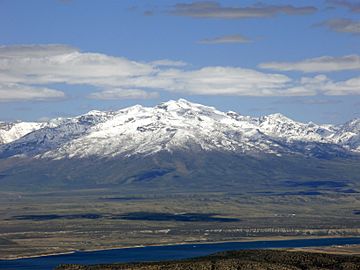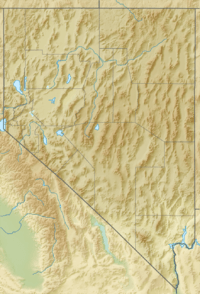Ruby Dome facts for kids
Quick facts for kids Ruby Dome |
|
|---|---|
 |
|
| Highest point | |
| Elevation | 11,392+ ft (3472+ m) NAVD 88 |
| Prominence | 4,793 ft (1,461 m) |
| Isolation | 94.73 mi (152.45 km) |
| Parent peak | South Schell Peak |
| Listing |
|
| Geography | |
| Location | Elko County, Nevada, U.S. |
| Parent range | Ruby Mountains |
| Topo map | USGS Ruby Dome |
| Climbing | |
| Easiest route | From Griswold Lake, Class 2 scramble east to the saddle between Griswold Lake and Seitz Canyon, then up to the saddle on either side of the summit and along the ridgeline |
Ruby Dome is a very tall mountain located in Nevada, United States. It is the highest point in the Ruby Mountains and also the tallest mountain in Elko County. Imagine standing on top of it – you'd be over 11,392 feet (3,472 meters) high! That's like stacking more than 20 Eiffel Towers on top of each other!
Ruby Dome is special because it stands out a lot from the land around it. It's the thirteenth most "prominent" peak in Nevada, meaning it rises very sharply from its surroundings. This amazing mountain is found about 21 miles (34 km) southeast of the city of Elko. It's part of the beautiful Ruby Mountains Ranger District, which is managed by the Humboldt-Toiyabe National Forest. From its base at about 6,000 feet (1,800 meters), it climbs all the way up to its impressive height. It's the tallest mountain for over 90 miles (145 km) in every direction!
Contents
Discovering Ruby Dome
Ruby Dome is a natural wonder. It's not just a big rock; it's an important part of the landscape. Mountains like Ruby Dome help shape the weather and provide homes for many plants and animals. They also offer stunning views for people who love to explore.
Where is Ruby Dome?
Ruby Dome is located in the northeastern part of Nevada. It's specifically in Elko County, which is a large area in the state. The mountain is the crown jewel of the Ruby Mountains range. This mountain range is known for its rugged beauty and clear alpine lakes. The entire area is part of the Humboldt-Toiyabe National Forest. This forest is one of the largest national forests in the United States. It covers parts of Nevada and eastern California.
How Tall is Ruby Dome?
Ruby Dome stands at an elevation of 11,392 feet (3,472 meters) above sea level. This makes it one of the highest peaks in Nevada. Its height means it often has snow on its upper slopes, even into the summer months. The air at the top is much thinner and cooler than at the bottom. This creates different environments as you climb higher.
Climbing Ruby Dome
Climbing Ruby Dome is an adventure for experienced hikers. The easiest way to reach the top starts near Griswold Lake. From there, climbers follow a path east. This path leads to a saddle, which is a low point between two peaks. This saddle is located between Griswold Lake and Seitz Canyon.
After reaching this saddle, hikers then climb up to another saddle. This one is on either side of the main summit. Finally, they follow the ridgeline to the very top. This type of climb is called a "Class 2 scramble." It means you might need to use your hands for balance sometimes. It's not a difficult rock climb, but it requires careful footing.
Nature Around Ruby Dome
The area around Ruby Dome is full of life. The different heights and weather conditions create many habitats. This means you can find a variety of plants and animals living there. The Humboldt-Toiyabe National Forest works to protect this natural beauty.
Plants and Trees
As you go up the mountain, the types of plants change. At lower elevations, you might see sagebrush and juniper trees. Higher up, you'll find forests of pine and fir trees. Near the very top, where it's colder and windier, only tough, low-growing plants can survive. These include alpine wildflowers that bloom in the short summer season.
Animals You Might See
The Ruby Mountains are home to many animals. You might spot mule deer grazing in open areas. Bighorn sheep are also known to live on the rocky slopes. Smaller animals like marmots and pikas can be seen near the high-altitude rocks. If you are very lucky, you might even catch a glimpse of a mountain lion or a black bear. Birds like eagles and hawks soar high above the peaks. They use the strong winds to glide and hunt.




